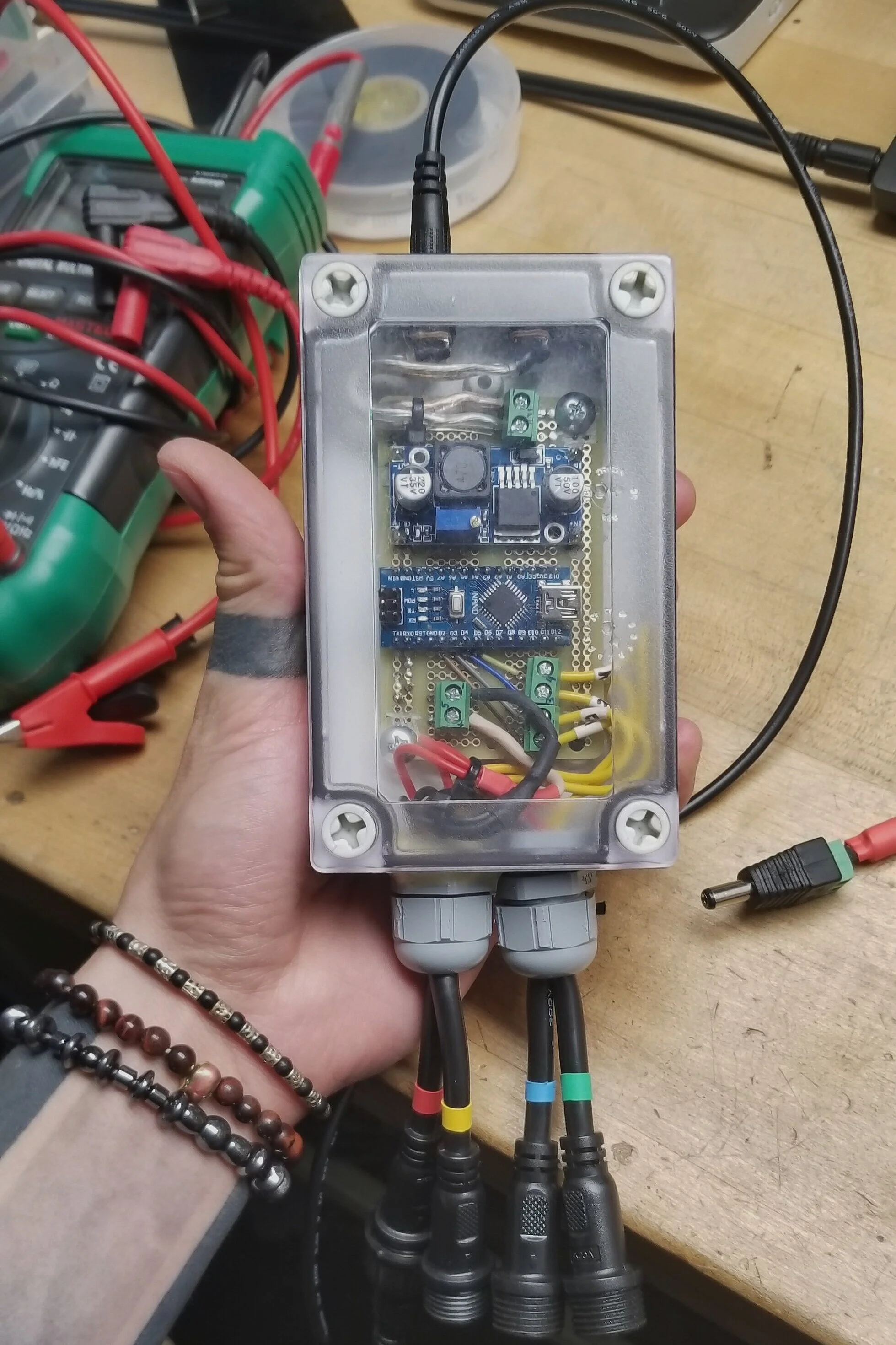Magic Wheelchair - a Frozen sled for Angelle
About a year ago I was invited to assist with a Magic Wheelchair project, where a team of crafty folks work to build a costume for a wheelchair bound kid. I agreed and took up the task of putting together an LED system for the costume.
Our team was paired up a young girl named Angelle, who’s favorite movie is Disney’s Frozen. Working with that inspiration and a taking into account her wheelchair shape, we settled on a design for a Frozen themed sled. Designed to fit onto chassis of the chair and move with it, the assembly ended up being quite a project.
An initial sketch
Sketch by Hellen McCarthy
Over the course of a few months, the team put together a pretty fantastic system to make it all happen. The costume itself is broken into 8 parts -
x2 Contoured side panels - Made from blue foam and rigidized with a plywood backer. They were mounted to to either side of the wheelchair, and constituted the bulk of the costume. These were sculpted with snowy swirls along their length, and included recessed LEDs.
x2 Sled runners - Mounted on either side and lower to the ground, these pieces had knockouts and polycarbonate windows finished with an icy crackle effect to make it look as if the sled was continuously running on ice.
x2 Frame mounts - These pieces tied the wheelchair to the 4 side pieces above, connecting the chassis of the wheelchair to the costume parts while not interfering with the operation of either. They utilized a series of 3-D printed brackets to lock pieces in.
x1 Front panel - The front panel tied the two contoured sides together, making rigid the whole of the pieces and keeping the sides from swaying while moving.
x1 Frozen themed gown - This was the gown that Angelle wore to really put a special flair on the costume.
This took a ton of engineering to make work, as wheelchairs are not made to have bulky add-ons attached to them. Shout-out to teammates Jacob LaRocca and Alex Crease for working this all up in CAD, as it was quite a lot of measuring, checking, re-designing, and drafting.
Once the pieces were drafted, production work started. In particular, the sculpting and subsequent finishing. The side pieces were fully sculpted out of foam by the powerhouse Hellen McCarthy, who also did the effects painting and hardcoat finishing of the pieces.
Concurrently to all the outer costume assembly work, Rebecca Knepple and Jason Kuehl headed up the cloth work and worked with students at Somerville High School to put together a flowing gown.
By the time I got to my part, the project was already looking fantastic…
One of the principle aspects I went into the LED system with was to keep in mind that it needed to be easy to understand and simple to use, so that it could be re-wired without fuss when Angelle’s family wanted to reassemble it. With that in mind, I made a plug-and-play system using color coded wires and simple locking connectors.
Overall the system is pretty straight forward, with 4 zones of LEDs within the system, 2 running in the deep groove of the contoured side panels, and 2 running along the interior upper edge of the sled runners. The controller is a self enclosure housing an arduino nano and a DC-DC step down buck converter to take a 12v input to 5v for the mini and the WS2812 LED strips.
Power goes in up top, LED power and data goes out the bottom.
Overall the assembly of the controller was the most complicated part of the project, as all the components in the box were soldered to the FR4-perf, and all the connections to that connected via screw terminals. Once all the connections were tested and the output of the DC-DC converter tuned, I started with the programming of the LED system. While the Arduino nano doesn’t pack a lot of processing power, I found that if it was set up to push the same animation on all 4 strips of LEDs concurrently it had enough juice to do so without issue.
The animation itself consists of a bright chase that works its way down the length of the strip, in addition to blue sparkles that happen at a randomized LEDs along the length.
Here’s the code if you want to take a look at it yourself - IceChase_v1.ino [2KB]
Once that was complete it was just a matter of installing the LEDs onto the sides and the runners.
And with that, we were good to go! After a year, we were ready to reveal all our work.
We did a quick fit-up in the field, and Angelle got to wear the costume for the first time…
Photos by Annie Cheung
And with that, we left the costume with the family, so they can use it whenever they please.
Overall quite a rewarding project to work on, especially with such a talented group of people. Thanks to Jacob, Hellen, Alex, Rebecca, Jason, and Science Bob for putting in so much work to make this happen. And thanks to the Magic Wheelchair foundation for providing this opportunity.
Until next time,
Mac Pierce













